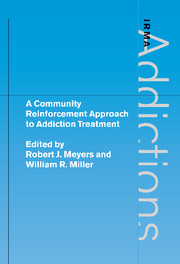Crossref Citations
This Book has been
cited by the following publications. This list is generated based on data provided by Crossref.
Smith, Jane Ellen
Meyers, Robert J.
and
Miller, William R.
2001.
The Community Reinforcement Approach to the Treatment of Substance Use Disorders.
The American Journal on Addictions,
Vol. 10,
Issue. s1,
Wilbourne, Paula L.
and
Miller, William R.
2002.
Treatment for Alcoholism.
Alcoholism Treatment Quarterly,
Vol. 20,
Issue. 3-4,
p.
41.
Miller, William R.
2002.
Educating Psychologists about Substance Abuse.
Substance Abuse,
Vol. 23,
Issue. 1_suppl,
p.
289.
Meyers, Robert J.
Miller, William R.
Smith, Jane Ellen
and
Tonigan, J. Scott
2002.
A randomized trial of two methods for engaging treatment-refusing drug users through concerned significant others..
Journal of Consulting and Clinical Psychology,
Vol. 70,
Issue. 5,
p.
1182.
O'Farrell, Timothy J.
and
Fals‐Stewart, William
2003.
ALCOHOL ABUSE.
Journal of Marital and Family Therapy,
Vol. 29,
Issue. 1,
p.
121.
Miller, William R.
2003.
Commentary.
Addiction,
Vol. 98,
Issue. 1,
p.
5.
van Gageldonk, André
Rigter, Henk
Ketelaars, Toine
and
van Laar, Margriet
2005.
Kansvolle psychosociale behandelingen voor problemen met illegale drugs.
Verslaving,
Vol. 1,
Issue. 2,
p.
62.
Meyers, Robert J.
Villanueva, Michael
and
Smith, Jane Ellen
2005.
The Community Reinforcement Approach: History and New Directions.
Journal of Cognitive Psychotherapy,
Vol. 19,
Issue. 3,
p.
247.
Jang, Soo Mi
and
Schoppelrey, Susan L.
2005.
Implementation of Contingency Management Substance Abuse Treatment in Community Settings.
Journal of Evidence-Based Social Work,
Vol. 2,
Issue. 1-2,
p.
41.
2005.
Conversation with Griffith Edwards.
Addiction,
Vol. 100,
Issue. 1,
p.
9.
Ripley, Jennifer S.
Cunion, April
and
Noble, Nicole
2006.
Alcohol Abuse in Marriage and Family Contexts.
Alcoholism Treatment Quarterly,
Vol. 24,
Issue. 1-2,
p.
171.
Podlesnik, Christopher A.
Jimenez-Gomez, Corina
and
Shahan, Timothy A.
2006.
Resurgence of alcohol seeking produced by discontinuing non-drug reinforcement as an animal model of drug relapse.
Behavioural Pharmacology,
Vol. 17,
Issue. 4,
p.
369.
Velleman, Richard
2006.
The importance of family members in helping problem drinkers achieve their chosen goal.
Addiction Research & Theory,
Vol. 14,
Issue. 1,
p.
73.
Heather, Nick
2007.
Handbook of Evidence‐based Psychotherapies.
p.
251.
Longabaugh, Richard
2007.
The Search for Mechanisms of Change in Behavioral Treatments for Alcohol Use Disorders: A Commentary.
Alcoholism: Clinical and Experimental Research,
Vol. 31,
Issue. s3,
Roozen, Hendrik G.
Wiersema, Hans
Strietman, Martin
Feij, Jan A.
Lewinsohn, Peter M.
Meyers, Robert J.
Koks, Margot
and
Vingerhoets, Ad J.J.M.
2008.
Development and Psychometric Evaluation of the Pleasant Activities List.
The American Journal on Addictions,
Vol. 17,
Issue. 5,
p.
422.
Abbott, Patrick J.
2009.
A Review of the Community Reinforcement Approach in the Treatment of Opioid Dependence.
Journal of Psychoactive Drugs,
Vol. 41,
Issue. 4,
p.
379.
MILLER, WILLIAM R.
2009.
Conversation with William R. Miller.
Addiction,
Vol. 104,
Issue. 6,
p.
883.
DeFuentes-Merillas, Laura
2009.
Belonen is effectief: Is het ethisch het dan niet toe te passen?.
Psychopraktijk,
Vol. 1,
Issue. 2,
p.
25.
Roozen, Hendrik G.
Blaauw, Eric
and
Meyers, Robert J.
2009.
Advances in Management of Alcohol Use Disorders and Intimate Partner Violence: Community Reinforcement and Family Training.
Psychiatry, Psychology and Law,
Vol. 16,
Issue. sup1,
p.
S74.





